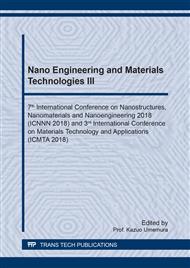p.82
p.91
p.96
p.103
p.109
p.114
p.119
p.125
p.130
Assistive Electro Discharge Machining of AIN Ceramics
Abstract:
Electro discharge machining process experiences limitation due to the non-conductive nature of the workpiece material. However, researchers proposed assistive EDM technique to machine nonconductive materials in the past. These assistive techniques require a minimal thickness of 100 µm conductive coating on the workpiece surface which usually takes longer time to coat the surface using PVD (physical vapor deposition) method. In this paper, a new modified assistive EDM method has been proposed to machine nonconductive Aluminum Nitride ceramics successfully. A three layers coating was used that included silver coating, carbon tape and silver nano-powder on a non-conductive aluminium nitride. This coating aids in conducting EDM operation due to the availability of conductive particles. Apart from the decomposition of dielectric that facilitates carbon particles on top of conductive carbon layer, coating itself also contributes in conductive silver particles. Therefore, carbon as well as silver debris that remains on the ceramics surface aids in continuous spark generation which in turn creates alternative thermal load and thus removes materials.
Info:
Periodical:
Pages:
109-113
Citation:
Online since:
March 2019
Authors:
Keywords:
Price:
Сopyright:
© 2019 Trans Tech Publications Ltd. All Rights Reserved
Share:
Citation:


